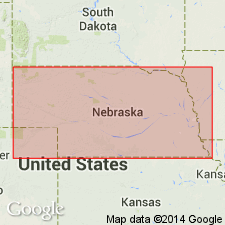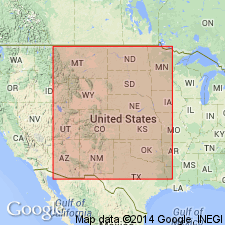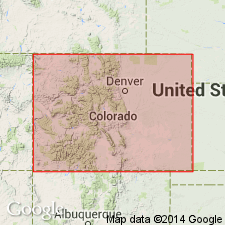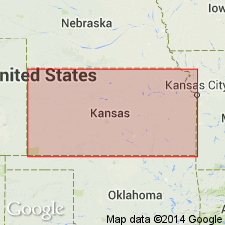
- Usage in publication:
-
- Omadi sandstone
- Modifications:
-
- Original reference
- Dominant lithology:
-
- Sandstone
- AAPG geologic province:
-
- Salina basin
Summary:
Pg. 15 (fig. 7), 18-19. Omadi sandstone of Dakota group. Since the time Dakota group was named it has been separated into three formations, upper one of which is yet called Dakota sandstone, a usage conflicting with the name of the group. Omadi sandstone is herein proposed for so-called Dakota formation to include section between Fuson and Graneros shales. Includes (ascending) Fall River, Skull Creek, and Newcastle members. Thickness about 147 feet. Age is Cretaceous.
Type section: in Missouri River bluffs extending through Omadi Twp., Dakota Co., eastern NE. Term Omadi relates to an abandoned town, Omaha Creek, and the Omaha Indians.
Source: US geologic names lexicon (USGS Bull. 1200, p. 2825).

- Usage in publication:
-
- Omadi sandstone*
- Modifications:
-
- Areal extent
- AAPG geologic province:
-
- Salina basin
Summary:
Name used in eastern NE (Webster, Rock, and Saunders Cos), and northeast part NE in the Salina basin. Is of Early Cretaceous (Albian) age.
Source: GNU records (USGS DDS-6; Denver GNULEX).

- Usage in publication:
-
- Omadi [formation]
- Modifications:
-
- Overview
- AAPG geologic province:
-
- Denver basin
Summary:
Is uppermost [formation] (of three) at top of Dakota group in the Denver basin in northeastern CO, southeastern WY, and western NE. Dakota group comprises the Cloverly, Skull Creek, and Omadi [formations]. Omadi is divided into (ascending) Cruise, Huntsman, and Gurley [members]. Omadi is shown correlative with the "J," "G," and "D" so-called Graneros sands and their intervening unnamed units; with the 3rd, 2nd, and 1st Dakota [sands] and their intervening unnamed units; and with the Lower Muddy and Upper Muddy and an intervening unnamed unit.
Source: GNU records (USGS DDS-6; Denver GNULEX).

- Usage in publication:
-
- Omadi formation
- Modifications:
-
- Areal extent
- AAPG geologic province:
-
- Salina basin
- Central Kansas uplift
- Anadarko basin
- Las Animas arch
Summary:
Is uppermost formation of Dakota group. Is divided into Cruise sandstone, Huntsman shale, and Gurley sandstone members in subsurface of KS; is extended in subsurface of KS into Salina basin, Central Kansas uplift, Anadarko basin, and Las Animas arch. Overlies Lower Cretaceous Kiowa formation or Permian beds where Comanchean (Lower Cretaceous) is absent. Underlies Upper Cretaceous Graneros shale. Is assigned to Gulfian Series (Upper Cretaceous).
Source: GNU records (USGS DDS-6; Denver GNULEX).
For more information, please contact Nancy Stamm, Geologic Names Committee Secretary.
Asterisk (*) indicates published by U.S. Geological Survey authors.
"No current usage" (†) implies that a name has been abandoned or has fallen into disuse. Former usage and, if known, replacement name given in parentheses ( ).
Slash (/) indicates name conflicts with nomenclatural guidelines (CSN, 1933; ACSN, 1961, 1970; NACSN, 1983, 2005, 2021). May be explained within brackets ([ ]).

